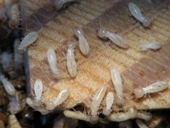Termites
Termites are found mainly in tropical and subtropical regions all over the world, where they are feared for their destructive effects on wood and other materials.
The damage caused by termites in wooden objects and structures is far greater than that caused by fungi. Normally, termites only destroy dead wood, but some species attack living trees and also wood-based materials, paper, textiles and plant fibres.
Where are termites found?
Up to now, more than 2000 different termite species have been documented, occurring mainly in Africa, South America and Australia. A few hundred of these are also wood destroyers. In Europe, particularly in France, Spain, Italy and Portugal, various species of wood-destroying termite can be found. These include Reticulitermes santonensis, Reticulitermes lucifugus and Kallotermes flavicollis.
How do termites live?
Termites are insects that live in colonies, each with a queen, a king and thousands of worker and soldier insects. The king and queen live together in a central chamber. After mating, the queen lays eggs continuously and is fed by the workers. These workers are responsible for building the nest and feeding the queen, while the soldiers defend the nest from intruders.
How do they attack wood?
Termites are photophobic and do not come out into daylight again after swarming. To cover any distance above ground, they build gallery runways which they move through. Wooden objects are destroyed from within so the outer shell can be left as a protective layer. This makes timbers with ground contact particularly vulnerable, as the termites living in the earth can attack them directly.
Interestingly, termites cannot actually digest cellulose themselves but have to rely on the help of microorganisms living in their abdomen. These organisms break down the cellulose into sugars which the termites can then digest.
How can wood be protected from termite infestation?
There are various ways of mechanically blocking termites’ access to wooden structures or buildings or, at least, making it more difficult. This is done with the help of metal termite barriers or plastic foils buried in the ground. With special wood preservatives that work preventively against termite infestation, treated wood can be provided with lasting protection, especially if the preservative is applied in a vacuum pressure process, allowing it to penetrated deep into the wood.
